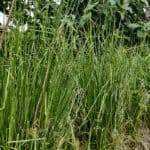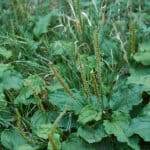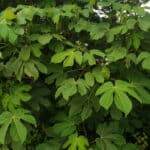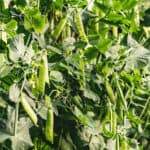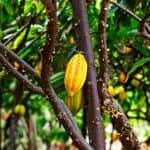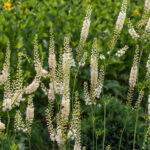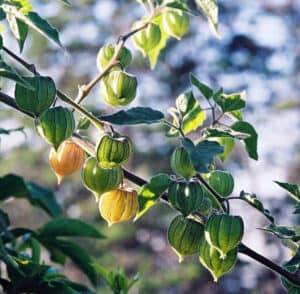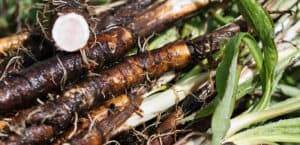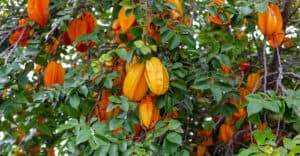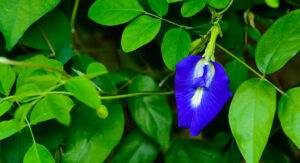Plant Overview
Rumex family species are prevalent along disturbed sites, fields, roadsides and abandoned lots. This biannual or perennial herbaceous plant can reach a height of 1.5 meters (5 feet) with its upright, smooth, tan to green speckled flowering stem in summer.
With their deep taproot, I consider these species to be dynamic accumulators and great garden members.
Dynamic accumulators are vigorous plants that suck up nutrients deep down in the subsoil and grow dense foliage that dies back every year, thus breaking down into its fundamental minerals and creating a healthy layer of rich topsoil. Dynamic accumulators are great for mulching and keeping the soil healthy and covered throughout all seasons.
While considered an injurious weed under the UK Weeds Act 1959, I personally think of Dock to be an invaluable gardening companion for its many benefits around the kitchen and garden.
Not only does it provide the top layers of the soil remineralization from deep below, it holds moisture and nutrients with its abundant biomass production, but in the kitchen I praise it for its versatility, it can be eaten as a fresh salad green when young, it can be stir fried like collards or kale, it can be used in lasagnas and casseroles, as well as a great refreshing potherb in soups and stews.
There are countless types of important Rumex varieies for the kitchen and garden. Of them I have experience with Rumex crispus (Sour Dock) and Rumex acetosella (Sheep Sorrel).
Main notable difference is that Rumex crispus leaves are considerably more curled and wavy, this variety is the more flavorful of the two and not as sour. Alternatively, as the Latin name acetosella suggests Sheep Sorrel has the most distinctive sour flavor. I know this leafy green as an excellent thirst quencher while hiking, as it is very prevalent along hiking routes in the higher altitudes of my temperate geographical region.
Propagation & Planting
Root division is usually the most reliable way to propagate Rumex. In my experience when planted they never grow where I want them to, mostly due to insects which harvest them and store the high carbohydrate seedlets. Dock roots are big, tough and hardy.
Digging them up in autumn and replanting in fertile soil at a depth of 3 inches below the soil surface will ensure you a glorious lush crop the following spring and for years to come. Regardless, Sorrel produces a vast quantity of seeds every season so you can strip them off the stalk and save them till winter passes in a cool dry spot.
When the ground is warm enough to work, plant seeds at a depth of about half an inch. I usually sprinkle the whole bunch very close together and once they are about 6 weeks old I transplant them from the “nursery” to their permanent locations at a distance of about 2 feet apart.
Growth and Care
In my observations, Dock generally grows bigger and lusher in partial shade. The quest to find light stresses them a little bit and they will spend more energy developing big leaves which capture any light under the tree canopy. The Rumex family enjoy rich moist humus which drains well.
I have noticed that when planted in equal parts aged compost, sand and soil (silt, clay mixture) Dock produces an abundance of vigorously growing leaves which are tender and soft longer than if planted just in the standard soil. I mulch my docks heavily in winter and you can see their spear shaped leaves poking through the hay and snow in the colder months.
Docks don’t really suffer from diseases apart from a few caterpillars biting the new fresh growth. I believe Rumex has evolved to be so incredibly sour that most herbivores wont even touch it. As far as diseases go, I haven’t had any experiences with anything detrimental which I can add. It really is a strong sturdy plant, and an undervalued garden member at that.
I have noticed that if I provide water more consistently than not, then the larger leaves are much more tender and palatable. Not only the young leaves are edible, but anything larger than a hand-with which should be too sour is also quite delicious.
Harvesting Dock
Best harvested when leaves are still quite small, no longer than a hands-width, for bigger leaves are too strongly flavored and will need several boilings to soften the sour/bitter taste. I usually pick a third of a plant every week, sometimes once every two weeks to give them time to recover, also the more I water them, the faster the regrowth rate.
A cropping tip I generally follow is to never take more than one third of the leaves at any given point. 90 percent of my harvests are in the early to mid spring months and once autumn arrives, mostly because the cool weather stimulates leaf production.
I usually take the shears along for the job as the leaf stalks are quite fibrous and it becomes a mess if you try to harvest bare handed. You could, though, pluck the leaves and they do make a satisfying poping sound as they get ripped from the base. When I don’t have time for entertainment I grab a handful of fresh tender young leaves from the center of the rosette and cut them all together at the base.
Processing & Utilizing
Blanched for ten seconds in boiling water with a teaspoon of citric acid or a splash of lemon will keep them from turning brown once you jar them or decide to pat them dry and freeze in a zip lock bag. I don’t have a big freezer so I like to pack them tight into a jar with a pinch of salt ‘n peppa, some garlic then I seal it, followed by pasteurization in a pressure cooker for 15 minutes.
This way or the freezer method ensures a slightly sour yet refreshing green year round. Dock is quite delicious in lasagnas, soups, pastas and many other recipes which call for collards, spinach or kale.
Conclusion
In conclusion, I feel this beautiful arrow-shaped leaved perennial gets a lot of hate for being a prolific seeder and for growing where not intended. Unfortunately, society has deemed the Rumex family as a nuisance but I feel with her lush rosette of leaves which wave in the wind year after year, providing us with a nice zesty sour kick for soups and stews, for salads and curries, not to forget all the minerals it mines and deposits on the topsoil.
I firmly believe that a garden without dock is not a self-sufficient or sustainable, let alone a permaculture garden. So let Dock grow in your yard and you will soon be addicted to propagating it in every corner and under every tree.






